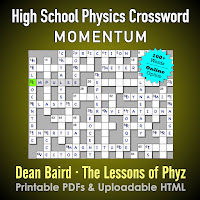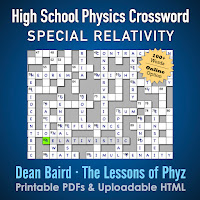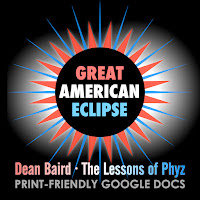The Chemistry textbook had a decent set of key terms for each chapter. Key terms in Biology were ... abundant! In the Astronomy textbook, I needed to supplement key terms with "non-key" terms from the chapters.
This brings me to the
OpenStax Physics: High School textbook. I aimed for about 50 topical terms (key and non-key terms from each chapter along with review terms from previous chapters as needed). Additional terms were added to fill the gaps in the puzzle. Additional terms could be physics or science-related. But they could also be from random tops all over the general knowledge board. State nicknames, chemical symbols, tech, Roman numerals, and so on.
As ever, the resulting puzzles each include over 100 words with over 150 crosses. "Busy crosswords".
I gave crosswords to students as they finished unit tests. It gave quick test-takers something to do while classmates finished their tests. I gave them puzzles for the upcoming unit of study. Each puzzle had enough non-chapter terms to keep students engaged before and while learning the upcoming unit.
All 23 puzzles, bundled and steeply discounted.
Puzzles 1-5 bundled and discounted.
Word Count: 109 Word Crosses (Puzzle Score): 166 Cross/Word Ratio: 1.52
Key Terms: Accuracy, Ampere, Atom, Base, Classical, Constant, Conversion, Dependent, Derived, Experiment, Exponential, Hypothesis, Independent, Intercept, Inverse, Kilogram, Law, LHC, Linear, Logarithmic, Log-log, Meter, Methods, Model, Modern, MRI, Notation, Observation, Order, Percents, Physical, Physics, Precision, Principle, Quadratic, Quantity, Quantum, Relationship, Relativity, Rosetta, Science, Second, Semi-log, Significant, Slope, Stonehenge, Theory, Uncertainty, Units, Universal
Selected Additional Terms: AI, Air, Angle, Deep, Echo, Fe, Fermi, GMO, HTML, IRL, Kelvin, Krypton, LA, mg, Micro, Motion, Nano, Pi, RNA, Sphere, Square, URL, VGA
Word Count: 119 Puzzle Score: 179 Cross/Word Ratio: 1.50
Key Terms: Acceleration, Accuracy, Atom, Average, Base, Constant, Delta, Dependent, Derived, Displacement, Distance, Experiment, Giga, Independent, Instantaneous, Inverse, Kilo, Kinematics, Linear, Magnitude, Mega, Meter, Methods, Observation, Physics, Pico, Position, Precision, Principle, Quantity, Reference, Rise, Run, Scalar, Science, Second, Slope, Speed, Speedometer, Tangent, Time, Uncertainty, Units, Universal, Vector, Velocity
Selected Additional Terms: Au, Cos, Cyan, Ear, Earth, Force, Fracture, Ga, Helium, Hot, Hydrogen, Ice, Ion, ISS, Jupiter, Mars, Mercury, Neptune, PCR, Pi, Pluto, Push, Quad, Rx, Saturn, Season, SEO, Sigma, Sin, Snow, SSD, Stereo, STP, Telescope, Ten, Tera, Uranus, URL, Venus
Word Count: 121 Puzzle Score: 180 Cross/Word Ratio: 1.49
Key Terms: Accelerator, Accuracy, Average, Base, Classical, Constant, Conversion, Deceleration, Delta, Displacement, Experiment, Giga, Gravity, Hypothesis, Instantaneous, Inverse, Kilo, Kilogram, Kinematic, Kinematics, Magnitude, Mega, Meter, Micro, Milli, Modern, Nano, Negative, Notation, Observation, Peta, Physics, Pico, Position, Precision, Quantum, Reference, Rise, Run, Scalar, Science, Second, Speed, Speedometer, Theory, Uncertainty, Units, Vector, Velocity, Vomit
Selected Additional Terms: Air, Atom, CDC, CME, Crater, ISS, Jupiter, Larva, Lithium, Mars, Mass, Mercury,, Neptune, Pulp, Rush, Saturn, Scholar, Strike, Twitter, UK, UV, Velocity, Weight
Word Count: 119 Puzzle Score: 190 Cross/Word Ratio: 1.60
Key Terms: Acceleration, Accelerator, Average, Coefficient, Constant, Deceleration, Delta, Dependent, Displacement, Distance, Dynamics, External, First, Force, Free, Freefall, Friction, Gravity, Independent, Inertia, Instantaneous, Kinematic, Kinematics, Law, Magnitude, Mass, Negative, Net, Newton, Normal, Position, Reference, Resistance, Scalar, Second, Speed, Speedometer, Sum, System, Tangent, Tension, Third, Thrust, Time, Vector, Velocity, Weight
Selected Additional Terms: AGN, ASL, Atom, Au, CME, Coma, Effect, External, GMO, Hot, ICE, Inch, Inert, Iridium, Jupiter, Kilogram, Knee, Luna, ma, MRI, Nagasaki, Nano, Neptune, Observation, Omega, Quotient, REM, rms, RN, Sister, State, Sunscreen, Tegu, Titania, TNT, UFO, Uranus, USB, Velocity, Xe
Word Count: 114 Puzzle Score: 197 Cross/Word Ratio: 1.73
Key Terms: Acceleration, Accuracy, Addition, Amplitude, Analytical, Atmospheric, Coefficient, Component, Deceleration, Deformation, Delta, Equilibrium, Free, Frequency, Friction, Graphical, Gravity, Harmonic, Head, Height, Hooke, Kinematic, Kinetic, Magnitude, Motion, Normal, Oscillate, Pendulum, Period, Periodic, Precision, Projectile, Pythagorean, Range, Resistance, Restoring, Resultant, Scalar, Slope, Speed, Speedometer, Static, Tail, Trajectory, Uncertainty, Vector, Vector, Velocity
Selected Additional Terms: Air, Cyst, Die, Document, Earth, edu, Euro, Galaxies, Jupiter, Mega, Mu, PET, Peta, Pi, Right, Saturn, Sodium, Toxic, Tungsten, Zn
Puzzles 6-10 bundled and discounted.
Word Count: 122 Puzzle Score: 187 Cross/Word Ratio: 1.53
Key Terms: Acceleration, Alpha, Amplitude, Angle, Angular, Arc, Centrifugal, Centripetal, Circular, Curvature, Distance, Dynamics, Equilibrium, Force, Frequency, Friction, Hooke, Kilogram, Kinematics, Lever, Mass, Meter, Newton, Normal, Omega, Oscillate, Period, Radian, Range, Rise, Rotational, Run, Scalar, Second, Slope, Spin, Tension, Theta, Thrust, Torque, Trajectory, Uniform, Universal, Vector, Velocity, Weight
Selected Additional Terms: AAAS, Acute, AIDS, Ape, BB, Be, CCD, Charge, Circular, CPR, Ear, Earth, Galileo, Grand, Gravity, Huron, Jupiter, Li, Mars, Micro, Nano, Neptune, NSF, NY, Observation, Odds, Orbital, Pd, Pearl, PhD, Pluto, Proton, Qi, Radio, Relativity, Resistance, Resultant, Rotates, Salt, Saturn, SETI, Speed, Starburst, Symptom, Te, Theory, Titan
Word Count: 117 Puzzle Score: 172 Cross/Word Ratio: 1.47
Key Terms: Acceleration, Accuracy, Angular, Aphelion, Arc,Centrifugal, Centripetal, Circular, Copernican, Curvature, Dynamics, Eccentricity, Einstein, Equilibrium, First, Force, Frequency, Geocentric, Gravitational, Gravity, Heliocentric, Kepler, Kinematics, Lever, Mass, Newton, Perihelion, Period, Planetary, Position, Precision, Principle, Ptolemaic, Rotational, Scalar, Second, Slope, Spin, Tangent, Third, Torque, Tycho, Uniform, Universal, Vector, Velocity, Weight
Selected Additional Terms: Acre, Ag, Apogee, Arch, Bq, CAH, DNA, Error, Gas, Greenland, HDL, Hybrid, Jupiter, Mars, Meter, Milli, Mu, Nano, Net, Nm, Oval, Peta, Pi, Pluto, Queen, RGB, Rh, Rough, RSS, Saturn, SHM, Sixty, Sn, Star, Straight, Tail, Time, Uranus, UV
Word Count: 117 Puzzle Score: 183 Cross/Word Ratio: 1.56
Key Terms: Angular, Aphelion, Change, Conservation, Copernican, Dynamics, Eccentricity, Einstein, Elastic, First, Force, Freefall, Friction, Geocentric, Gravitational, Gravity, Harmonic, Heliocentric, Impulse, Inelastic, Inertia, Isolated, Kepler, Magnitude, Mass, Momentum, Newton, Oscillate, Perfectly, Perihelion, Period, Planetary, Point, Position, Ptolemaic, Recoil, Scalar, Second, Theorem, Third, Torque, Tycho, Universal, Vector, Velocity
Selected Additional Terms: Amazon, Atom, Catalyst, Cookie, Ear, Earth, Ellipse, Equals, Giga, Gram, Higgs, IBM, Iceland, iOS, Jupiter, Mega, Mercury, Meter, Moon, Neptune, Optics, Penicillin, Pi, ROM, RSV, Run, Saturn, SEO, Snow, States, Sum, Sun, Tail, Tc, Vinyl
Word Count: 122 Puzzle Score: 186 Cross/Word Ratio: 1.66
Key Terms: Advantage, Angular, Axle, Change, Complex, Conservation, Efficiency, Elastic, Energy, Fd, Friction, Gravitational, Ideal, Impulse, Inclined, Inelastic, Input, Isolated, Joule , Kinetic, Lever, Mass, Mechanical, mgh, Momentum, mv, Output, Perfectly, Point, Potential, Power, Pulley, Rate, Recoil, Screw, Simple, Steam, Theorem, Torque, Velocity, Watt, Wedge, Work
Selected Additional Terms: Acronym, Acute, Air, Alloy, CME, DC, Drive, Experiment, First, Flex, Force, Ga, Geocentric, Gravity, He, Heliocentric, HTTP, Hypatia, Instantaneous, ISS, Jupiter, Kilowatt, Leaf, Mercury, Mumps, Ne, Neptune, Os, Pacific, Pluto, Podcast, Ruler, Static, Synonym, Tera, Time, Venus, Volume
Word Count: 112 Puzzle Score: 179 Cross/Word Ratio: 1.60
Key Terms: Binding, Centripetal, Change, Conservation, Contraction, Defect, Dilation, Efficiency, Einstein, Elastic, Energy, Ether, Factor, Force, Galileo, General, Geocentric, GPS, Gravitational, Heliocentric, Impulse, Inertia, Inertial, Joule, Kinetic, Light, Mass, Mechanical, Momentum, Morley, Newton, Normal, Oscillate, Period, Planetary, Postulate, Potential, Power, Proper, Reference, Relativistic, Relativity, Rest, Simultaneity, Special, Theorem, Universal, Velocity, Watt, Weight, Work
Selected Additional Terms: ACL, Atlantic, Atom, CTE, Datum, Erie, GOES, Inertial, Juneau, MPEG, Nb, Neptune, Net, Ni, Ovum, Pi, Radio, Screw, Sea, Six, Speed, State, Sum, Swarm, United, Vein, VLSI, Watt, Web, XML
Puzzles 11-12 bundled and discounted.
Word Count: 116 Puzzle Score: 186 Cross/Word ratio: 1.60
Key Terms: Absolute, Atom, Boiling, Capacity, Celsius, Condensation, Conduction, Conservation, Convection, Degree, Deposition, Efficiency, Equilibrium, Fahrenheit, Freezing, Fusion, Gas, Heat, Input, Ionization, Joule, Kelvin, Kinetic, Latent, Mass, Melting, Output, Phase, Plasma, Point, Potential, Power, Radiation, Recombination, Scale, Specific, Sublimation, Temperature, Thermal, Vaporization, Velocity, Water, Watt, Work, Zero
Selected Additional Terms: Acceleration, Angstrom, Circle, Earth, Earthling, Eon, EV, Eye, GIF, Giga, Gold, Hadron, Hot, Ice, IG, Impulse, Inventor, Iowa, Jr, Jupiter, KHz, Lie, Linear, Neptune, Nova, Order, Oslo, Pad, Pair, Plant, Potential, Power, RNA, SHM, Sting, Stop, Tesla, Tiger, Uranus, Venus, Wuhan
Word Count: 118 Puzzle Score: 176 Cross/Word Ratio: 1.49
Key Terms: Absolute, Boiling, Boltzmann, Capacity, Celsius, Condensation, Conduction, Convection, Cyclical, Degree, Deposition, Efficiency, Engine, Entropy, Equilibrium, Expansion, Fahrenheit, First, Freezing, Fusion, Gas, Heat, Ideal, Internal, Ionization, Kelvin, Latent, Melting, Mercury, Metabolism, Pascal, Phase, Photosynthesis, Plasma, Point, Pressure, Pump, PV, Radiation, Recombination, Scale, Second, Specific, Sublimation, Temperature, Thermal, Transduction, Vaporization, Water, Zero, Zeroth
Selected Additional Terms: Air, API, Atom, Borneo, Brahe, CMOS, EKG, Energy, Force, Hz, IR, Jupiter, Lab, Mars, mm, Pi, Rate, SOH, Spider, SSD, Ulna, Up, Uranus, URL, USB, Wave, Zn
Puzzles 13-17 bundled and discounted.
Word Count: 117 Puzzle Score: 177 Cross/Word Ratio: 1.51
Key Terms: Amplitude, Antinode, Constructive, Crest, Deformation, Destructive, Displacement, Earthquakes, Energy, Equilibrium, Force, Frequency, Harmonic, Hooke, Inertia, Inversion, Joule, Kinematics, Kinetic, Longitudinal, Magnitude, Mass, Mechanical, Medium, Nodes, Oscillate, Period, Periodic, Position, Power, Pulse, Reflection, Refraction, Richter, Seismic, SHM, Speed, Standing, Superposition, Tension, Transverse, Trough, Vector, Velocity, Wave, Wavelength, Weight, Work
Selected Additional Terms: Area, Au, Bison, Bouquet, Cs, DESI, Earth, Fluid, Forearm, Forest, FPS, Higgs, Hz, Image, Instantaneous, Jupiter, Kr, Llm, Mirror, Ohm, Pacific, Pi, Qi, Rain, RNA, Saturn, Spider, STEM, STP, Titan, Uniform, UV, Venus, Volt, Zero
Word Count: 116 Puzzle Score: 174 Cross/Word Ratio: 1.5
Key Terms: Amplitude, Antinode, Audible, Beat, Compression, Constructive, Crest, Damping, Decibel, Destructive, Doppler, Earthquakes, Energy, Frequency, Fundamental, Harmonics, Hearing, Intensity, Inversion, Lambda, Level, Longitudinal, Loudness, Mechanical, Medium, Natural, Nodes, Overtones, Period, Periodic, Pitch, Power, Pulse, Rarefaction, Reflection, Refraction, Resonance, Resonate, Richter, Seismic, SHM, Sonic, Sound, Standing, Superposition, Transverse, Trough, Velocity, Wave, Wavelength
Selected Additional Terms: Ampere, Atlas, Au, Dissect, DNA, Earth, Eureka, Evolve, Ga, Hand, ICE, Igloo, Mega, Melanin, Meter, ml, Mo, Model, Nautilus, Neural, Object, Persia, Pi, POTUS, Precision, Remedy, Rh, RNA, Toxic, Unit, Velocity, Water, Work
Word Count: 112 Puzzle Score: 166 Cross/Word Ratio: 1.48
Key Terms: AM, Amplitude, Beat, CFL, Damping, Decibel, Destructive, Doppler, Electric, Electromagnetic, Emr, Fm, Frequency, Fundamental, Gamma, Hearing, Illuminance, Infrared, Intensity, Interference, Inversion, Led, Light, Loudness, Lumens, Luminous, Lux, Magnetic, Maxwell, Mechanical, Medium, Microwave, Natural, Periodic, Pigment, Pitch, Polarized, Pulse, Radio, Rarefaction, Reflection, Refraction, Resonance, Sonic, Sound, Superposition, Transverse, Ultraviolet, Velocity, Wave, Wavelength, Xrays, Year
Selected Additional Terms: Accuracy, Astronomy, Average, CGI, Cloud, Eardrum, Fd, IR, Laser, Lava, LCD, Leap, LIGO, Mars, mm, MPEG, mv, Neon, Np, Realistic, SHM, Slope, Stable, Tan, TNT, Trajectory, Ulna, UV
Word Count: 124 Puzzle Score: 174 Cross/Word Ratio: 1.40
Key Terms: Aberration, AM, Angle, Central, Chromatic, Concave, Converging, Convex, Critical, Diffused, Dispersion, Diverging, Electric, EMR, FM, Gamma, Hyperopia, Illuminance, Incidence, Incident, Index, Infrared, Interference, Internal, Laser, Law, LED, Length, Lens, Light, Luminous, Magnetic, Maxwell, Microwave, Mirror, Myopia, Pigment, Point, Polarized, Radio, Radius, Ray, Real, Reflection, Refracted, Refraction, Snell, Specular, Ultraviolet, Virtual, Xrays, Year
Selected Additional Terms: Andes, Biology, Bq, CAH, CCD, Co, Cornea, Corona, DM, DNA, Elementary, Force, Heat, Heliocentric, ICE, Ion, Ir, JD, Manga, Mars, Nano, Neutron, Nile, No, PE, PGP, pH, Pi, Pico, Pluto, RGB, RNA, Saturn, Shark, Si, Teach, Trek, Unit, Venus, Work
Word Count: 118 Puzzle Score: 183 Cross/Word Ration: 1.55
Key Terms: Aberration, Chromatic, Concave, Converging, Convex, Critical, Diffraction, Diffused, Dispersion, Diverging, Gamma, Grating, Huygens, Incidence, Incident, Index, Infrared, Interference, Interference, Internal, Iridescence, Laser, Law, LED, Length, Lens, Light, Magnification, Maxwell, Microwave, Mirror, Monochromatic, Monochromator, Point, Polarized, Radio, Ray, Rayleigh, Real, Reflection, Refracted, Refraction, Resolution, Snell, Specular, Ultraviolet, Virtual, Wavefront, Xrays, Year
Selected Additional Terms: AM, Arsenic, Bismuth, Cancer, CD, Earth, Einstein, Engine, Eurasia, Fe, First, GIF, Graph, Hand, HEIF, Ice, Indigo, Insomnia, IR, Iris, km, Ovary, QED, Roof, ROV, sec, Skin, Sonic, SOS, Tangent, Teflon, Tera, Tremor, Umami, UV, Vein, Venus, Xe, XLV
Puzzles 18-20 bundled and discounted.
Word Count: 115 Puzzle Score: 185 Cross/Word Ratio: 1.61
Key Terms: Absolute, Capacitor, Capacity, Celsius, Conductor, Conservation, Copernican, Coulomb, Dielectric, Einstein, Electron, Elektron, Energy, Fahrenheit, Farad, Field, Field, First, Gas, Geocentric, Gravitational, Gravity, Heat, Heliocentric, Induction, Insulator, Inverse, Kelvin, Kepler, Kinetic, Newton, Nucleus, Phase, Planetary, Plasma, Polarization, Potential, Proton, Ptolemaic, Radiation, Second, Semiconductor, Specific, Temperature, Test, Thermal, Third, Torsion, Tycho, Universal, Volt, Xrays, Zero
Selected Additional Terms: API, Arctic, Camera, CDC, Circle, Cos, Crater, Cyan, Exponent, Eye, Hg, Infrared, Jupiter, Kinematics, Land, Lens, Mars, Mercury, MN, Nuclear, Optics, Rough, Saturn, Sec, SIMM, Sin, Sixty, Static, STEM, TIR, TNT, Uranus, Wave
Word Count: 118 Puzzle Score: 175 Cross/Word Ratio: 1.48
Key Terms: AC, Alternating, Ampere, Capacitor, Circuit, Conductor, Conservation, Conventional, Coulomb, Current, DC, Diagram, Dielectric, Direct, Electron, Elektron, Energy, Equivalent, Farad, Field, Franklin, Induction, Insulator, Inverse, Joule, Nanometer, Nonohmic, Nucleus, Ohm, Ohmic, Parallel, Polarization, Potential, Power, Proton, Resistance, Resistor, Semiconductor, Series, Silicon, Steady, Test, Torsion, Volt, Watt
Selected Additional Terms: Air, AQI, Aspirin, Au, Cd, Copper, CPU, Darwin, Equilibrium, EV, Experiment, Free, GIF, HDTV, Ion, Isotope, Jupiter, Loudness, Lux, Methods, mm, Neon, PDF, Phase, Pi, Ptolemy, RCS, Sirius, SOH, Static, Storm, Tangent, Titan, TOA, Uniform, Universal, Uranus, Visual, Zinc
Word Count: 118 Puzzle Score: 174 Cross/Word Ratio: 1.47
Key Terms: AC, Alternating, Ampere, Capacitor, Circuit, Conductor, Conservation, Conventional, Coulomb, Curie, Current, DC, Diagram, Dielectric, Dipole, Direct, Domain, Electric, Electromagnet, Electromagnetism, Electron, EMF, Energy, Equivalent, Faraday, Ferromagnetic, Field, Flux, Franklin, Generator, Induction, Insulator, Inverse, Joule, Magnetized, Nanometer, North, Nucleus, Ohm, Parallel, Permanent, Pole, Potential, Proton, Resistance, Resistor, Right, Series, Silicon, Solenoid, South, Steady, Test, Volt
Selected Additional Terms: Ag, Am, amu, Attract, Cos, Cs, Digit, Drag, Egypt, EPA, Europium, Giga, Hz, Ice, La, LLM, Mars, Mass, Mercury, Minute, Neuron, Node, Oil, Oxygen, Pico, Quantity, Rain, ROV, Sin, Sn, Sound, Spine, STEVE, Tan, Ten, TIR, Unum, URL, Venus, VPN, Water
Puzzles 21-23 bundled and discounted.
Word Count: 108 Puzzle Score: 152 Cross/Word Ratio: 1.41
Key Terms: AM, Blackbody, Catastrophe, Compton, Concave, Converging, Convex, Critical, Debloglie, Diffraction, Dispersion, Diverging, Duality, Electric, EMR, FM, Frequency, Gamma, Grating, Huygens, Incidence, Incident, Index, Infrared, Interference, Internal, Iridescence, Kinetic, Laser, LED, Length, Lens, Luminous, Magnetic, Maxwell, Microwave, Mirror, Momentum, Photoelectric, Photoelectron, Photon, Photovoltaic, Planck, Point, Polarized, Quantized, Quantum, Radio, Ray, Rayleigh, Refracted, Resolution, Ultraviolet, Wavefront, Wavelength, Xrays
Selected Additional Terms: Area, Beach, Cm, Corona, DNA, Exa, Exam, Eye, Faraday, HDL, Hg, Ice, Ion, KE, LAN, Metric, Oersted, pH, Pi, Polio, River, Scalar, Sixty, Sound, Tail, Tan, Ton, UFO, Volume
Word Count: 119 Puzzle Score: 187 Cross/Word Ratio: 1.57
Key Terms: Activity, Alpha, Anger, Atomic, Becquerel, Beta, Blackbody, Chain, Compton, Constant, Critical, Dating, Dating, DeBroglie, Decay, Duality, Effectiveness, Electric, Energy, Excited, Fission, Fraunhofer, Fusion, Gamma, Geiger, Ground, Halflife, Heisenberg, Hydrogen, Isotope, Kinetic, Liquid, Mass, Momentum, Nucleons, Photon, Planck, Planetary, Proton, Quantized, Quantum, Rad, Radioactive, Radioactivity, Radiopharmaceutical, Roentgen, Rutherford, Rydberg, Scintillator, Strong, Tagged, Therapeutic, Transmutation
Selected Additional Terms: ACL, Alpha, Asia, CCD, CDC, CFC, Circle, Cu, DC, DND, EFT, Frequency, Heat, HTTP, Kr, Light, Mars, Monkey, Moon, Moving, Mu, Net, Odyssey, Reactor, Rise, Saturn, Stem, Ten, Tera, Theory
Word Count: 121 Puzzle Score: 184 Cross/Word Ratio: 1.52
Key Terms: Annihilation, Antimatter, Bang, Baryon, Beam, Bottom, Carrier, Charmed, Chromodynamics, Color, Cyclotron, Down, Electrodynamics, Electroweak, Epoch, Era, Everything, Fermi, Feynman, Flavor, Gluons, Grand, Graviton, Hadron, Higgs, Inflationary, Lepton, LHC, LIGO, Mass, Meson, Negative, Neutral, Pair, Photon, Physics, Pion, Positive, Positron, Quark, SLAC, Standard, Strange, Strong, Superforce, Synchrotron, Top, Up, Weak, Yukawa
Selected Additional Terms: AI, Binding, Bismuth, Catastrophe, CM, CO, Delta, Diffraction, GOES, GW, Halflife, Helium, Hermes, HTML, ICE, Inert, Inertia, IRL, Laser, Ma, MM, MP, Newton, Photoelectric, Pi, Pico, Planetary, Plasma, Potassium, Qi, Quantum, Radioactive, Rhino, Rubidium, Sea, Stable, Theorem, TIR, Tusk
































